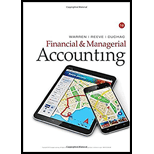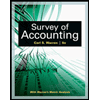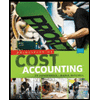
a.
Direct Material cost:
Direct material cost is the cost of the material which is directly involved in the production. It constitutes the major portion of the total cost of the finished product. For example: The cost of plastic is the direct material for manufacturing a bottle.
Direct Labor Cost:
Direct labor cost is the cost of the labor paid to the employees who are directly involved in converting the raw materials to the finished products. It constitutes the major portion of the total cost of the finished product. For example: Wages paid to the mechanic for repairing an automobile.
Factory overhead cost is the cost other than the direct material cost, and the direct labor cost which is not directly involved in the production process of converting the raw materials to the finished products. If the direct material cost or direct labor cost does not constitute the major portion of the total cost of the finished product, then it may be classified as the factory overhead cost. For example: Cost of repairing, and maintaining factory equipment.
To identify: The given costs as direct materials (DM), direct labor (DL), or factory overhead (FO) for a magazine publisher.
b.
To identify: The given costs as direct materials (DM), direct labor (DL), or factory
c.
To identify: The given costs as direct materials (DM), direct labor (DL), or factory overhead (FO) for a magazine publisher.
d.
To identify: The given costs as direct materials (DM), direct labor (DL), or factory overhead (FO) for a magazine publisher.
Trending nowThis is a popular solution!

Chapter 15 Solutions
Bundle: Financial & Managerial Accounting, Loose-Leaf Version, 14th + CengageNOWv2, 2 terms Printed Access Card
- Given the solution and accountingarrow_forwardCan you explain the correct methodology to solve this general accounting problem?arrow_forwardRadiant Logic Ltd. has net sales of $295,000, cost of goods sold of $190,000, selling expenses of $18,000, and non-operating expenses of $7,500. What is the company's gross profit?arrow_forward
 Managerial AccountingAccountingISBN:9781337912020Author:Carl Warren, Ph.d. Cma William B. TaylerPublisher:South-Western College PubPrinciples of Accounting Volume 2AccountingISBN:9781947172609Author:OpenStaxPublisher:OpenStax College
Managerial AccountingAccountingISBN:9781337912020Author:Carl Warren, Ph.d. Cma William B. TaylerPublisher:South-Western College PubPrinciples of Accounting Volume 2AccountingISBN:9781947172609Author:OpenStaxPublisher:OpenStax College Survey of Accounting (Accounting I)AccountingISBN:9781305961883Author:Carl WarrenPublisher:Cengage Learning
Survey of Accounting (Accounting I)AccountingISBN:9781305961883Author:Carl WarrenPublisher:Cengage Learning Principles of Cost AccountingAccountingISBN:9781305087408Author:Edward J. Vanderbeck, Maria R. MitchellPublisher:Cengage Learning
Principles of Cost AccountingAccountingISBN:9781305087408Author:Edward J. Vanderbeck, Maria R. MitchellPublisher:Cengage Learning College Accounting, Chapters 1-27AccountingISBN:9781337794756Author:HEINTZ, James A.Publisher:Cengage Learning,
College Accounting, Chapters 1-27AccountingISBN:9781337794756Author:HEINTZ, James A.Publisher:Cengage Learning, Managerial Accounting: The Cornerstone of Busines...AccountingISBN:9781337115773Author:Maryanne M. Mowen, Don R. Hansen, Dan L. HeitgerPublisher:Cengage Learning
Managerial Accounting: The Cornerstone of Busines...AccountingISBN:9781337115773Author:Maryanne M. Mowen, Don R. Hansen, Dan L. HeitgerPublisher:Cengage Learning





